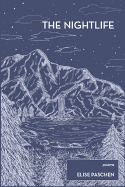
It's hard to make old forms feel fresh. While most contemporary poets seem to have done away with formal constraints altogether, others still push boundaries, creating meta-textual pieces on how one reads, or making the words' placement on the page act out the poem's meaning. Chicago poet Elise Paschen does both in The Nightlife, a collection mostly focused on death, love and how both seep into our conscious and subconscious lives.
She begins with her most daring formal experiment, "Closing House," which places two parallel narratives side by side on the page until they combine into a devastating final line. It invites the reader to experience a disaster from both near and far, to push the narratives together until they are one. While it would be fine to see Paschen continue in the vein of "Closing House," she has different experiments to perform.
Other works, like "The Tree Agreement," make subtle shifts in an otherwise typical structure. For instance, the poem rhymes "hack" and "backyard," forcing the reader to accept both assonance and dissonance at once (much like the argument over a tree that the poem depicts). Here Paschen nods to dream logic, and many of the other poems fully embrace it. Objects both fit together and don't; ideas make sense and can't. The poems that focus on the dreams of the surrealist painters Juan Miró and Salvador Dalí make this connection explicit. The Nightlife ultimately leaves the reader feeling dreamy herself, a notable success for the collection. --Noah Cruickshank, adult engagement manager, the Field Museum, Chicago, Ill.

